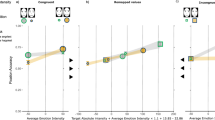Abstract
The Spatial-Numerical Association of Response Codes (SNARC) effect is characterised by a spatial cognitive representation of low numbers to the left side of space and high numbers to the right side of space. This effect has been found using a diversity of stimuli and experimental paradigms. However, the influence of emotional stimuli on this effect remains unclear. In this study, the SNARC effect is analysed in relation to pairs of emotional facial stimuli (happy–neutral, sad–neutral and happy–sad pairs). Gaze patterns of 151 participants were analysed when exposed to a free-viewing eye-tracking paradigm consisting of pairs of emotional faces preceded by small and large numbers. Replicating previous results, a standard SNARC effect was found independently of the emotional expressions of the faces (i.e., there was a significant linear trend of number magnitude in the frequency of first fixations of the gaze to the left side space). However, specific slope analyses revealed that the SNARC effect was influenced by the spatial position of each emotion presented in the emotional pairs. Specifically, the effect disappeared in happy–neutral trials, when the happy faces were allocated in the right position and also in happy–sad trials when two emotional stimuli were simultaneously displayed. The study revealed that the SNARC effect is sensitive to the spatial position of emotional stimuli which further adds to other known limits of the phenomenon. The limitations of the study and its implications in the area of cognition and emotion are also discussed.



Similar content being viewed by others
References
Armstrong, T., & Olatunji, B. O. (2012). Eye tracking of attention in the affective disorders: A meta-analytic review and synthesis. Clinical Psychology Review, 32(8), 704–723. https://doi.org/10.1016/j.cpr.2012.09.004.
Blanco, I., Serrano-Pedraza, I., & Vazquez, C. (2017). Don’t look at my teeth when I smile: Teeth visibility in smiling faces affects emotionality ratings and gaze patterns. Emotion, 17(4), 640–647. https://doi.org/10.1037/emo0000260.
Blanco, I., Poyato, N., Nieto, I., Boemo, T., Pascual, T., Roca, P., & Vazquez, C. (2019). Attentional biases in dysphoria when happy and sad faces are simultaneously presented. Journal Behavior Therapy & Experimental Psychiatry, 65, 101499. https://doi.org/10.1016/j.jbtep.2019.101499.
Bradley, B. P., Mogg, K., & Lee, S. C. (1997). Attentional biases for negative information in induced and naturally occurring dysphoria. Behaviour Research and Therapy, 35(10), 911–927. https://doi.org/10.1016/s0005-7967(97)00053-3
Bulf, H., Macchi Cassia, V., & de Hevia, M. D. (2014). Are numbers, size, and brightness equally efficient in orienting visual attention? Evidence from an eye-tracking study. PLoS ONE, 9(6), e99499. https://doi.org/10.1371/journal.pone.0099499.
Calvo, M. G., & Avero, P. (2005). Time course of attentional bias to emotional scenes in anxiety: Gaze direction and duration. Cognition and Emotion, 19, 433–451. https://doi.org/10.1080/02699930441000157.
Calvo, M. G., & Nummenmaa, L. (2011). Time course of discrimination between emotional facial expressions: The role of visual saliency. Vision Research, 51, 1751–1759. https://doi.org/10.1016/j.visres.2011.06.001.
Calvo, M. G., Nummenmaa, L., & Avero, P. (2008). Visual search of emotional faces. Experimental Psychology, 55(6), 359–370. https://doi.org/10.1027/1618-3169.55.6.359.
Cipora, K., & Wood, G. (2017). Finding the SNARC instead of hunting it: A 20∗20 Monte Carlo investigation. Frontiers in Psychology, 8, 1194. https://doi.org/10.3389/fpsyg.2017.01194.
Dehaene, S., Bossini, S., & Giraux, P. (1993). The mental representation of parity and number magnitude. Journal of Experimental Psychology: General, 122(3), 371–396. https://doi.org/10.1037/0096-3445.122.3.371.
Epp, A. M., Dobson, K. S., Dozois, D. J. A., & Frewen, P. A. (2012). A systematic meta-analysis of the Stroop task in depression. Clinical Psychology Review, 32(4), 316–328. https://doi.org/10.1016/j.cpr.2012.02.005
Fias, W., & Fischer, M. H. (2005). Spatial representation of numbers. In J. I. D. Campbell (Ed.), Handbook of mathematical cognition (pp. 43–54). New York: Psychology Press.
Fias, W., Brysbaert, M., Geypens, F., & d’Ydewalle, (1996). The importance of magnitude information in numerical processing: Evidence from the SNARC effect. Mathematical Cognition, 2(1), 95–110. https://doi.org/10.1080/135467996387552.
Fischer, M. H., & Shaki, S. (2014). Spatial associations in numerical cognition-From single digits to arithmetic. Quarterly Journal of Experimental Psychology, 67(8), 1461–1483. https://doi.org/10.1080/17470218.2014.927515.
Fischer, M. H., Warlop, N., Hill, R. L., & Fias, W. (2004). Oculomotor bias induced by number perception. Experimental Psychology, 51(2), 91–97. https://doi.org/10.1027/1618-3169.51.2.91.
Foulsham, T., Gray, A., Nasiopoulos, E., & Kingstone, A. (2013). Leftward biases in picture scanning and line bisection: A gaze-contingent window study. Vision Research, 78, 14–25. https://doi.org/10.1016/j.visres.2012.12.001.
Frischen, A., Eastwood, J. D., & Smilek, D. (2008). Visual search for faces with emotional expressions. Psychological Bulletin, 134(5), 662–676. https://doi.org/10.1037/0033-2909.134.5.662.
Hartmann, M. (2015). Numbers in the eye of the beholder: What do eye movements reveal about numerical cognition? Cognitive Processing, 16(1), 245–248. https://doi.org/10.1007/s10339-015-0716-7.
Hartmann, M., Martarelli, C. S., Mast, F. W., & Stocker, K. (2014). Eye movements during mental time travel follow a diagonal line. Consciousness and Cognition, 30, 201–209. https://doi.org/10.1016/j.concog.2014.09.007.
Hoffmann, D., Hornung, C., Martin, R., & Schiltz, C. (2013). Developing number–space associations: SNARC effects using a color discrimination task in 5-year-olds. Journal of Experimental Child Psychology, 116(4), 775–791. https://doi.org/10.1016/j.jecp.2013.07.013.
Koster, E. H. W., Crombez, G., Van Damme, S., Verschuere, B., & De Houwer, J. (2004). Does imminent threat capture and hold attention? Emotion, 4(3), 312–317. https://doi.org/10.1037/1528-3542.4.3.312.
Kowler, E. (2011). Eye movements: The past 25years. Vision Research, 51(13), 1457–1483. https://doi.org/10.1016/j.visres.2010.12.014.
Lang, P. J., Bradley, M. M., & Cuthbert, B. N. (1997). Motivated attention: Affect, activation, and action. In P. J. Lang, R. F. Simons, & M. Balaban (Eds.), Attention and orienting: Sensory and motivational processes (pp. 97–135). New Jersey: Routledge.
Lee, E., Kang, J. I., Park, I. H., Kim, J. J., & An, S. K. (2008). Is a neutral face really evaluated as being emotionally neutral? Psychiatry Research, 157(1–3), 77–85. https://doi.org/10.1016/j.psychres.2007.02.005.
Lewis, E. J., Blanco, I., Raila, H., & Joormann, J. (2019). Does repetitive negative thinking affect attention? Differential effects of worry and rumination on attention to emotional stimuli. Emotion. https://doi.org/10.1037/emo0000535.
Leyman, L., De Raedt, R., Schacht, R., & Koster, E. H. (2007). Attentional biases for angry faces in unipolar depression. Psychological Medicine, 37(3), 393–402. https://doi.org/10.1017/S003329170600910X.
Loetscher, T., Bockisch, C. J., Nicholls, M. E., & Brugger, P. (2010). Eye position predicts what number you have in mind. Current Biology, 20, R264–R265. https://doi.org/10.1016/j.cub.2010.01.015.
López-Gómez, I., Hervás, G., & Vázquez, C. (2015). Adaptación de la “Escala de afecto positivo y negativo” (PANAS) en una muestra general española. Bahavior Psychology/Psicología Conductual, 23(3), 529–548.
Lundqvist, D., Flykt, A., Öhman, A. (1998). The karolinska directed emotional faces - KDEF [CD ROM]. Department of Clinical Neuroscience, Psychology section, Karolinska Institutet, (ISBN: 91-630-7164-9).
Macnamara, A., Keage, H. A. D., & Loetscher, T. (2018). Mapping of non-numerical domains on space: Asystematic review and meta-analysis. Experimental Brain Research, 236(2), 335–346. https://doi.org/10.1007/s00221-017-5154-6.
Myachykov, A., Cangelosi, A., Ellis, R., & Fischer, M. H. (2015). The oculomotor resonance effect in spatial–numerical mapping. Acta Psychologica, 161, 162–169. https://doi.org/10.1016/j.actpsy.2015.09.006.
Nava, E., Rinaldi, L., Bulf, H., & Macchi Cassia, V. (2017). Visual and proprioceptive feedback differently modulate the spatial representation of number and time in children. Journal of Experimental Child Psychology, 161, 161–177. https://doi.org/10.1016/j.jecp.2017.04.012.
Nummenmaa, L., & Calvo, M. G. (2015). Dissociation between recognition and detection advantage for facial expressions: A meta-analysis. Emotion, 15(2), 243. https://doi.org/10.1037/emo0000042.
Olatunji, B. O., Ciesielski, B. G., Armstrong, T., & Zald, D. H. (2011). Emotional expressions and visual search efficiency: Specificity and effects of anxiety symptoms. Emotion, 11(5), 1073–1079. https://doi.org/10.1037/a0021785.
Ouellet, M., Santiago, J., Israeli, Z., & Gabay, S. (2010). Is the future the right time? Experimental Psychology, 57(4), 308–314. https://doi.org/10.1027/1618-3169/a000036.
Pitt, B., & Casasanto, D. (2018). Spatializing emotion: No evidence for a domain-general magnitude system. Cognitive Science, 42(7), 2150–2180. https://doi.org/10.1111/cogs.12568.
Pool, E., Brosch, T., Delplanque, S., & Sander, D. (2016). Attentional bias for positive emotional stimuli: a meta-analytic investigation. Psychological Bulletin, 142(1), 79–106. https://doi.org/10.1037/bul0000026.
Raila, H., Scholl, B. J., & Gruber, J. (2015). Seeing the world through rose-colored glasses: People who are happy and satisfied with life preferentially attend to positive stimuli. Emotion, 15, 449–462. https://doi.org/10.1037/emo0000049.
Ruiz-Fernández, S., Rahona, J. J., Hervás, G., Vázquez, C., & Ulrich, R. (2011). Number magnitude determines gaze direction: Spatial–numerical association in a free-choice task. Cortex, 47(5), 617–620. https://doi.org/10.1016/j.cortex.2010.10.006.
Sanchez, A., & Vazquez, C. (2014). Looking at the eyes of happiness: Positive emotions mediate the influence of life satisfaction on attention to happy faces. The Journal of Positive Psychology, 9(5), 435–448. https://doi.org/10.1080/17439760.2014.910827.
Savage, R. A., Lipp, O. V., Craig, B. M., Becker, S. I., & Horstmann, G. (2013). In search of the emotional face: Anger versus happiness superiority in visual search. Emotion, 13, 758–768. https://doi.org/10.1037/a0031970.
Spering, M., & Carrasco, M. (2015). Acting without seeing: Eye movements reveal visual processing without awareness. Trends in Neurosciences, 38(4), 224–258. https://doi.org/10.1016/j.tins.2015.02.002.
Vallesi, A., Weisblatt, Y., Semenza, C., & Shaki, S. (2014). Cultural modulations of space-time compatibility effects. Psychonomic Bulletin & Review, 21(3), 666–669. https://doi.org/10.3758/s13423-013-0540-y.
van Gompel, R. P., Fischer, M. H., Murray, W. S., & Hill, R. L. (2007). Eye-movement research: An overview of current and past developments. In R. P. van Gompel, M. H. Fischer, W. S. Murray, & R. L. Hill (Eds.), Eye movements: A window on mind and brain (pp. 1–28). Amsterdam: Elsevier.
Viarouge, A., Hubbard, E. M., & McCandliss, B. D. (2014). The cognitive mechanisms of the SNARC effect: An individual differences approach. PLoS ONE, 9(4), e95756. https://doi.org/10.1371/journal.pone.0095756.
Watson, D., Clark, L. A., & Tellegen, A. (1988). Development and validation of brief measures of positive and negative affect: The PANAS scales. Journal of Personality and Social Psychology, 54(6), 1063–1070. https://doi.org/10.1037//0022-3514.54.6.1063.
Acknowledgements
We thank Prof. Almudena Duque, Teodoro Pascual, Natalia Poyato, Pablo Roca, and Teresa Boemo for their collaboration. The help provided by Rosa Maria Zangri to edit this paper is also greatly appreciated.
Funding
This work was supported by the Spanish Ministry of Economy and Competitiveness grants PSI2014-61764 (EXPLORA), PSI2014-56303-REDT, and PSI2015-69253-R to the third author, the Ministry of Education predoctoral Fellowship BES-2013-064936 to the first author, and Complutense University predoctoral fellowship (CT17/17-CT18/17) to the second author.
Author information
Authors and Affiliations
Corresponding author
Ethics declarations
Conflict of interest
All authors declare no conflict of interest.
Ethical approval
All procedures performed in studies involving human participants were in accordance with the ethical standards of the institutional and/or national research committee and with the 1964 Helsinki Declaration and its later amendments or comparable ethical standards. The study was approved by the University Ethics Committee.
Informed consent
Informed consent was obtained from all individual participants included in the study. To ensure anonymity, the names of participants were replaced with code numbers to process and analyse the data.
Additional information
Publisher's Note
Springer Nature remains neutral with regard to jurisdictional claims in published maps and institutional affiliations.
Rights and permissions
About this article
Cite this article
Blanco, I., Nieto, I. & Vazquez, C. Emotional SNARC: emotional faces affect the impact of number magnitude on gaze patterns. Psychological Research 85, 1885–1893 (2021). https://doi.org/10.1007/s00426-020-01375-4
Received:
Accepted:
Published:
Issue Date:
DOI: https://doi.org/10.1007/s00426-020-01375-4




